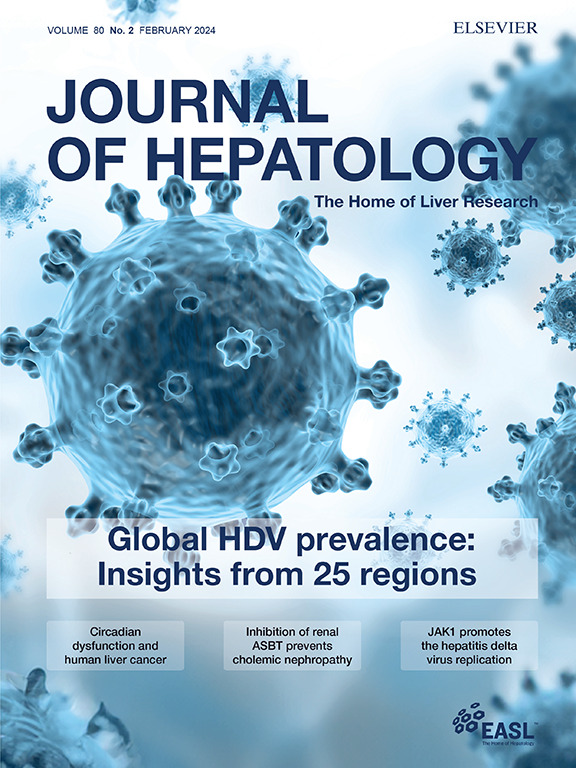From HCV to HEV: Repurposing a nucleoside analogue for hepatitis E therapy
IF 33
1区 医学
Q1 GASTROENTEROLOGY & HEPATOLOGY
引用次数: 0
Abstract
Section snippets
Background and context
Hepatitis E virus (HEV) infection is a substantial public health burden leading to approximately 20 million acute infections per year. The majority of infections are self-limiting, but relevant risks remain for pregnant women and immunocompromised patients, in whom HEV infection is associated with acute liver failure and chronic HEV infection, respectively.1 HEV genotypes 1 (HEV-1) and 2 (HEV-2) are highly prevalent in low-income Asian and African countries, transmission occurs faecal-orally,Objectives, methods and findings
The study by Zhang and colleagues investigated the antiviral effect of nucleoside analogues, originally developed against the hepatitis C virus (HCV), on HEV.8 Of the 19 different sugar-modified guanosine analogues tested, JNJ-9117 exhibited the most potent, broad-spectrum, in vitro antiviral activity against HEV-1, HEV-3, and rat HEV in various cell lines, including primary human hepatocytes and non-hepatic cell lines. Comparisons with ribavirin and sofosbuvir – an HCV polymerase inhibitorSignificance of findings
The study published by Zhang et al. demonstrates the in vitro and in vivo efficacy of JNJ-9117 in treating HEV infection, with a high resistance barrier and good tolerability in the animal model. JNJ-9117 was originally developed as a direct-acting antiviral to treat HCV infection, as it targets the viral polymerase. The imperative structural motifs of the catalytic site of the RdRp are comparable between HCV, HEV 1-4 and rat HEV, explaining the antiviral efficacy of JNJ-9117 in both HCV andFinancial support
The authors did not receive any financial support to produce this manuscript.Conflict of interest
The authors of this study declare that they do not have any conflict of interest.Please refer to the accompanying ICMJE disclosure forms for further details.从丙型肝炎到戊型肝炎:重新利用核苷类似物治疗戊型肝炎
背景和背景戊型肝炎病毒(HEV)感染是一项重大的公共卫生负担,每年导致约2000万例急性感染。大多数感染是自限性的,但孕妇和免疫功能低下患者仍然存在相关风险,其中HEV感染分别与急性肝功能衰竭和慢性HEV感染相关HEV基因型1 (HEV-1)和2 (HEV-2)在低收入的亚洲和非洲国家高度流行,传播发生在粪口。目的、方法和发现Zhang及其同事的研究调查了核苷类似物的抗病毒作用,最初是针对丙型肝炎病毒(HCV)开发的,在19种不同的糖修饰鸟苷类似物中,JNJ-9117对HEV-1、HEV-3和HEV- 8表现出最有效的、广谱的体外抗病毒活性。以及各种细胞系的大鼠HEV,包括原代人肝细胞和非肝细胞系。与利巴韦林和索非布韦(HCV聚合酶抑制剂)的比较研究结果的意义Zhang等发表的研究证实了JNJ-9117在体外和体内治疗HEV感染的有效性,在动物模型中具有高耐药屏障和良好的耐受性。JNJ-9117最初是作为治疗HCV感染的直接抗病毒药物开发的,因为它靶向病毒聚合酶。RdRp催化位点的必要结构基序在HCV、HEV 1-4和大鼠HEV之间具有可比性,这解释了JNJ-9117对HCV和资金支持的抗病毒效果。作者没有获得任何资金支持来撰写这篇论文。利益冲突本研究的作者声明他们没有任何利益冲突。详情请参阅随附的ICMJE披露表格。
本文章由计算机程序翻译,如有差异,请以英文原文为准。
求助全文
约1分钟内获得全文
求助全文
来源期刊

Journal of Hepatology
医学-胃肠肝病学
CiteScore
46.10
自引率
4.30%
发文量
2325
审稿时长
30 days
期刊介绍:
The Journal of Hepatology is the official publication of the European Association for the Study of the Liver (EASL). It is dedicated to presenting clinical and basic research in the field of hepatology through original papers, reviews, case reports, and letters to the Editor. The Journal is published in English and may consider supplements that pass an editorial review.
 求助内容:
求助内容: 应助结果提醒方式:
应助结果提醒方式:


